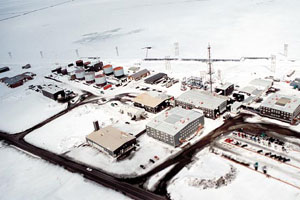At first glance, the tundra seems life a flat terrain with small, worn out plateaus (from previous geological eras) that barely rise above sea level. It is a vast geographical extension, because if we only consider the arctic tundra (there is also the alpine and the tropical alpine tundra) we are referring to approximately 20, 000 square kilometers.
The tundra is characterized by two fundamental features: its soil contains a deep layer that is always frozen (permafrost) and the amount of vegetation is scarce (only moss, lichen and some bushes, especially during the summer season). The tundra has two strongly marked seasons. Winters prevails during most of the year, covering the landscape with a significant amount of ice and diminishing the presence of animal (which migrate or hibernate) and plant species.
Summer only lasts two months, during which the tundra completely transforms. It goes from being a nearly deserted and inhospitable territory, to a perfect environment for the development of vegetable relationships, the mating of some mammals and the appearance of an important amount of foods that attract many birds, insects and other organisms.
Types of tundra
The tundra is usually identified as a territory that belongs to high latitudes, near the poles. Although this statement is accurate, it is necessary to point out that there are two more kinds of tundra that are not in these latitudes: the alpine tundra and the alpine tropical tundra.
– Alpine tundra: it maintains the general characteristics that identify this ecological region: low temperatures, a short summer season and low precipitation, because the environmental cold prevents the circulation of vapor. This tundra is present in the high mountain areas of the entire world. It has a thinner permafrost when compared to the arctic tundra. In addition, its soils are drier and precipitation in the form of snow, as well as humidity, are higher.
– Tropical alpine tundra: one of its most singular characteristics is the development of special, tall plant vegetation. Although small vegetable organisms develop in both the artic and alpine tundra, huge plants grow in the tropical zones, which reach over six meters tall, branched and even non-branched. The characteristics we will analyze later refer mainly to the arctic tundra.
Climatic conditions
The tundra is a cold land, of strong winds, considerable snowfalls and ample temperature fluctuations, which makes the different organisms that inhabit it be adapted to such extreme conditions.
Generally, the average temperatures fluctuate between –15°C and 5°C. The closeness of the land to the sea affects the constitution of these parameters. Due to this, it is possible to differentiate between a maritime climate, with moderate temperature variations and precipitation, and a continental climate, drier and with extremely cold winters. Precipitation is usually scarce, reaching up to 300 millimeters annually.
However, the environmental humidity is high because evaporation is low and the frozen ground captures and retains a considerable amount of water. The duration of hours of solar radiation also vary considerably according to the seasons. The summer months have almost permanent sunlight, while in winter, it practically disappears, making life in the tundra even more extreme.
Soil
The soil of the tundra is fundamentally determined by two factors: the freezing and thawing of the upper layers that make it up, and the existence of a deeper layer called permafrost. In geology, any portion of substrate or soil that experiences temperatures below 0°C for two years or more is dubbed permafrost. Without a doubt, one of the tundra’s deepest layers deserves this moniker, as it even remains frozen in summer. Permafrost’s highest point of change takes place in summer.
Due to the slight increase in temperature, its superficial layers begin to melt, allowing the growth of a few vegetable organisms and stagnating considerable water masses inside the plain, which cannot drain due to the permanent freezing of the innermost layer of permafrost. During summer, only the surface thaws, while permafrost remains a few layers down. Regarding the alternated process of freezing and fusion (thawing and the formation of swamps), a small natural cycle takes place on the surface, during which the soil level elevates and then goes down again.
This enables the nutrients housed within it to circulate, accomplishing some of the biochemical cycles that are vital for all forms of life, like that of carbon and oxygen. It must be pointed out that rock meteorization also takes place on the surface of the tundra. This is a form of mechanical fragmentation, caused by the rock’s inner physical tension.
The action of ice is fundamental to this process, because a mere drop of water in a small crack in the rock can fragment it into small pieces, without altering its mineral composition.
Vegetation
In the tundra, the only ones that, barely, survive are plant species that are capable of withstanding the constant alteration of the soil and the ice and wind. Even the atmosphere has peculiar characteristics that condition any form of life at these latitudes. It is thinner, so the luminous intensity, especially relating to ultraviolet rays, is very high on sunny days.
Although rain is scarce, the flooded ground and difficult evaporation deliver the necessary hydro supply for the survival of these vegetable organisms. Mosses and lichen are the species that manage to overcome these great obstacles during most of the year.
The situation is different in summer.
The brief thawing that takes place for approximately two months enables the flowering of rushes, heathers, willows, tiny birches and grasses, among others. This does not only imply a considerable increase of organic diversity, but also translates into a great abundance of nutrients for the area’s herbivores and excellent shelter for depredation.
The existent vegetation also participates in an interesting decomposition process, which ultimately forms the so-called peat. These true swamps, which have a higher presence during thawing, are formed from the slow decomposition of dead or partially disintegrated plant remains, which pile up in flooded areas.
Fauna
If we consider the tundra’s extreme environmental conditions, we could hardly imagine the exuberant fauna that in fact develops there. Diverse vertebrate and invertebrate organisms are capable of beating adversity and adapting their vital rhythms to the changes of season and temperature, among other factors. It must also be pointed out that the number of species spread out in the tundra changes abruptly with the beginning of each season.
When winter arrives, many animals travel to more temperate areas for the season and return at the beginning of summer. In summer, the tundra becomes the place of choice for many mammals to reproduce, as well as an adequate zone for birds due to the abundance of food.
Among the vertebrates that dominate the frozen inner territories of the tundra are the Caribou (Rangifer tarandus), the Moose (Alces alces), the Musk ox (Ovibos lagopus), the Arctic hare (Lepus arcticus), the lemmings, the Wolf (Canis lupus) and the Polar bear (Ursus maritimus).
Each of them has special features that make their life in the tundra easier, like the arctic fox, which almost doubles its fur in winter in order to withstand the low temperatures, or the polar bear, which has hollow hairs that have an impermeable translucent surface. We will see some organic adaptations more in-depth further ahead. On their part, another focus of species biodiversity takes place in the coastal areas, made up by whales, seals, beluga whales, otters and a few fish and crustaceans.
However, the dominators of the area are birds, attracted by the abundance of food. It is also noteworthy that during winter, thousands of crustaceans are left frozen on the tundra’s surface, a situation that changes with the arrival of the first rays of sun, as they begin to emerge little by little, becoming suspended in the flooded surfaces and attracting a great amount of insects. This becomes a real feast for the birds, which take advantage of this unbeatable opportunity. Standouts among them are the crane, geese, dunlins, curlews, redshanks, Snowy ptarmigans (Lagopus mutus) and the Snowy owl (Nyctea scandiaca), among others. Of all these species, only a few are capable of staying and surviving the cold season, therefore most of them travel south in search of heat.
Man and tundra: difficult coexistence
The arctic tundra is not a comfortable home for human beings. It has always been characterized for having low population density. Centuries ago, some tribes settled in these cold lands. Among them, were the Inuit, commonly known as Eskimos, and the Sami, inhabitants of the arctic zones of North America and Eurasia respectively.
These inhabitants lifestyle was in ecological harmony with the environment around them, taking advantage of the natural resources they had in a balanced way. However, at the beginning of last century and especially in the last few decades, this situation changed drastically. Attracted by resources as important as gold, oil and the present wildlife, Man weakened the established balance and thoughtlessly devastates this ecological region’s resources to this day.The tribes’ temporary settlements were replaced by permanent ones built out of synthetic materials; the light sleighs driven by animals gave way to heavy vehicles that, although enable better movement, crush the soil and typical vegetation of the spot, even altering the food chain.
The exploitation of oil has also generated constant waste that pollutes the environment. The potential risk of dangerous spills of the coveted energy resource is also present. If we analyze the situation of the alpine tundra, we can note that the situation is not much better. Many high altitude areas are used for pasturing domestic cattle, which directly affects the area’s soil and vegetation. The construction of roads, rec-centers and hiking trails have paved the way for Man to alter the normal behavior of biotic and abiotic factors.
Alaska, endangered ecological sanctuary
At the beginning of the year 2000, a heated political and environmental debate began regarding the exploitation of the oil resources present in Alaska. Although this resource was already extracted from some arctic zones in previous decades, during the first semester of 2005, some companies received authorization to take advantage of the resources of a special area: the Alaska natural reserve, known as Arctic National Wildlife Refuge (ANWR, its acronym in English).
This 79,380 square kilometer refuge is an almost virgin territory, which can only be reached by boat and whose biological wealth is so great that many compare it to the Serengeti National Park in Africa. In addition, it is the habitat of species like the polar bear, the brown bear, wolves, arctic foxes, musk oxen, moose, bison, whales, walruses and over 180 species of birds (among which geese, eagles and falcons stand out); on top of it all, each summer the landscape is invaded by thousands of caribous, which travel over 70 thousand kilometers from Canada to breed and graze.
The deposits of oil are located beneath the surface where the animals live. Some estimates state that these reserves could equal over 10 thousand million barrels of crude oil, and in a period of ten years, a million barrels a day could be extracted (reducing, in part, the United State’s dependency on middle eastern countries.).
The area chosen for the oil drilling (due to the abundance of resources) is precisely the coastal plain where most of the animals gather. In order to exploit the oil reserves, the construction of huge platforms is necessary, which according to scientific research, would hinder the normal movement and reproduction of species like the caribou, as well as incite polar bears to abandon their cubs.








